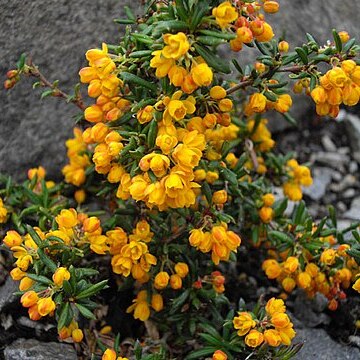Shrubs, evergreen, 1-2(-3) m tall. Branches dark gray, terete, sometimes sulcate, scarcely verruculose; shoots grayish yellow, terete; spines 3-fid, adaxially flat, 1-2.5 cm, stout. Petiole 1-2 mm; leaf blade abaxially yellow-green, adaxially dark green, oblong, oblong-elliptic, or oblong-obovate, 3.5-10 × 1-2.5 cm, very rigidly leathery, abaxially not pruinose, midvein obviously raised, adaxially with impressed midvein, both surfaces with indistinct lateral and reticulate veins, base cuneate, margin 5-18-spinose-serrate on each side, apex acute, aristate. Flowers 7-20-fascicled. Pedicels 5-11 mm; bractlets 2, reddish, ovate-triangular, ca. 2.2 × 1.5 mm, apex acute. Sepals in 3 whorls; outer sepals ovate, ca. 3 × 2.4 mm; median sepals suborbicular, ca. 5 × 4 mm; inner sepals obovate-oblong, ca. 7 × 5 mm. Petals obovate, ca. 5 × 3.8-4 mm, base shortly clawed, with separate glands, apex emarginate. Stamens ca. 3 mm; anther connective slightly prolonged, rounded. Ovules 2 or 3. Berry red when mature, obovoid-oblong, 7-8 × ca. 5 mm, pruinose, style persistent; seeds 2 or 3. Fl. Mar-Apr, fr. Jun-Sep.
More
Glabrous evergreen shrub to c. 2 m high. Shoots pale yellowish, angled. Spines 3-partite, the main axis to 5 cm long. Lvs sessile or subsessile, 5-9 × 0.7-1.4 cm on flowering branches, narrowly lanceolate, rigidly coriaceous, shining above; margins spiny serrate and revolute; base attenuate to cuneate; apex spiny. Fls to 17 in fascicles, occasionally more. Bracts 2-3 mm long, ovate, mucronate. Pedicels c. 10 mm long at anthesis, becoming dark crimson. Perianth segments to 6 mm long, yellow, those of outermost whorl 1-2 mm long. Nectaries prominent. Stamens c. 3 mm long. Ovules 4. Style short. Stigma very large. Berry 5-7 mm diam., globose or subglobose, black and pruinose; fruiting style 0.5-1 mm long.
A shrub. It keeps its leaves throughout the year. It grows 1-2 m tall. It has spines. The leaves are oblong and 4-10 cm long by 1-3 cm wide. They are yellow-green underneath. The flowers are in groups of 7-20. The fruit are red berries. They are oval and 7-8 mm long by 5 mm wide.
Can be grown by cuttings or seedlings. Seeds needs stratification.

